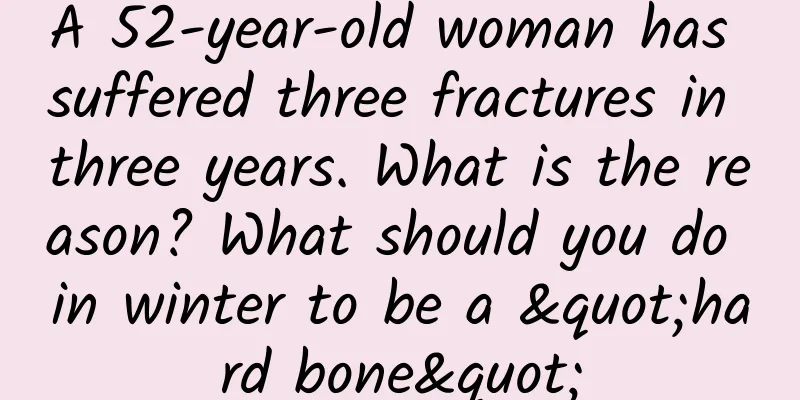A 52-year-old woman has suffered three fractures in three years. What is the reason? What should you do in winter to be a "hard bone"

|
My classmate's aunt is 52 years old, looks very young, with fair skin. I heard that she broke her bones again recently. This is her third fracture in three years. The first two were just hand fractures, which were cured with conservative treatment at the local hospital. This time it was no small matter, it was a femoral neck fracture, which required surgery. In addition, the doctor told her that she had severe osteoporosis, which was an important cause of her fracture. 1. What is osteoporosis? Osteoporosis is a systemic bone disease characterized by decreased bone mass and damage to bone tissue microstructure, leading to increased bone fragility and susceptibility to fractures. Osteoporosis is divided into two categories: primary osteoporosis and secondary osteoporosis. Among them, primary osteoporosis includes postmenopausal osteoporosis (type I), senile osteoporosis (type II) and idiopathic osteoporosis (including juvenile type). Secondary osteoporosis refers to osteoporosis caused by any disease and/or drug that affects bone metabolism and other clear causes. 2. What are the clinical manifestations and risk factors of osteoporosis? 1. Frequent back pain or body pain, which will be aggravated when turning over, sitting up, after walking for a long time, at night or during weight-bearing activities. 2. Spinal deformation causes hunchback, shortened height, difficulty breathing, abdominal pain, bloating, etc. 3. Common sites of fractures are the spine, hip (proximal femur), forearm and upper arm; a small number of patients may have no symptoms and suffer fractures directly. 3. What are the risk factors for osteoporosis? High-risk factors include: advanced age, postmenopausal women, low body weight, low sex hormones, coffee and carbonated drinks, lack of exercise and immobilization, dietary calcium and/or vitamin D deficiency, low sunlight, few outdoor activities, smoking, alcoholism and drugs, etc. It needs to be emphasized that vitamin D deficiency is common among the Chinese population, especially the elderly population. Due to dietary factors, reduced outdoor activities, reduced gastrointestinal absorption and other factors, they have become the highest risk group for vitamin D deficiency. Fractures caused by osteoporosis have become an important cause of bedriddenness and even death among the elderly, bringing great pain to the elderly. Don’t ignore medications Drugs that may cause or aggravate osteoporosis include: glucocorticoids, lithium salts, antiepileptic drugs, heparin, phenytoin sodium, proton pump antagonists (≥1 year), thyroxine (excessive replacement or inhibition doses), serotonin reuptake inhibitors, etc. 4. So, how can we confirm that osteoporosis has occurred? Medical history and physical examination are the basic basis for clinical diagnosis, and the final diagnosis depends on X-ray examination or bone density measurement. The first is a brittle fracture, also known as an osteoporotic fracture, which is usually spontaneous or caused by minor trauma. Normal people will not have fractures due to minor trauma, but it is very easy to occur in osteoporosis patients. Fractures are commonly found in the spine, hip, wrist and other parts of the body. The second method is to check through instruments. Dual-energy X-ray absorptiometry (DXA) is currently the most widely recognized bone density test. Compared with normal young people, a decrease of 2.5 standard deviations in bone density is considered a diagnosis of osteoporosis. That is, a T value of ≤-2.5 is diagnosed as osteoporosis; -2.5 < T value <-1.0 is osteopenia. A T value of ≥-1.0 is normal. 5. How to maintain healthy living habits to prevent osteoporosis and even fractures? 1. Eat a balanced diet rich in calcium, protein and low in salt; 2. Quit smoking, drink less alcohol, and try to drink less coffee and carbonated drinks; 3. Moderate exercise and scientific sun exposure are important. The main source of vitamin D in the human body is synthesised by the skin through sunlight, followed by food and supplements. Adjust the time of sun exposure according to different seasons. For example, in winter, you can choose to go out in the sun around noon, while in summer, you should avoid excessive exposure to the sun at around 10 am and 3 pm. With the face and arms exposed, 30 minutes of sun exposure a day can meet the daily vitamin D requirement, but the time should be appropriately extended in winter and spring. However, it should be noted that it is ineffective to sunbathe through glass or apply sunscreen when going outdoors. Ultraviolet rays are easily blocked by glass and sunscreen. 4. Keep exercising to prevent falls and injuries and reduce the risk of fractures Exercise is an important part of the treatment and prevention of osteoporosis. Lack of movement or immobilization can cause a decrease in bone mass and muscle mass. It is recommended to start slowly and gradually increase the amount of activity, walking for 30 minutes a day and doing resistance exercise 2-3 times a week. 5. Monitor bone density. Women aged ≥65, men aged ≥70, or men aged 65 or older with a history of fracture need to have their bone density checked at least once. If you are at high risk of osteoporosis, the screening age can be advanced. If osteoporosis is diagnosed, you should regularly use anti-osteoporosis drugs under the guidance of a doctor and have regular follow-up examinations. 6. That aunt had three fractures in three years. What was the reason? She is a postmenopausal woman. In order to lose weight, she does not eat many foods. She is rather thin and particularly obsessed with beauty. She always applies sunscreen when going out, takes a car when going out, and does not like outdoor activities. These are all causes of her multiple fractures after suffering from osteoporosis. Calcium and vitamin D are basic drugs for daily prevention and treatment of osteoporosis. The doctor also suggested that in addition to drug treatment, the aunt should pay attention to the balanced intake of milk, eggs and fruits in her diet, consciously receive sunlight, and exercise scientifically, which will help prevent and treat osteoporosis and avoid fractures again. Warm reminder: High-risk groups should go to regular hospitals for osteoporosis testing as soon as possible to achieve early diagnosis, early prevention, and early treatment. Don't wait until you are injured or sick to know how to prevent it! |
<<: How did beetles get their hard shells?
>>: Why are wind turbines white?
Recommend
How to cancel the authorization of Mini Program? How to cancel authorization of Mini Program?
Q: How to cancel the authorization of the mini pr...
Morning jogging has many benefits, but can it cause illness? Fitness enthusiasts must be careful!
In today's society where people are paying mo...
Can Windows tablets make a comeback?
Are you still using a tablet computer? Has the sc...
Do your desks and chairs meet the standards? It is related to children's health and cannot be ignored
Reference standard: "Functional dimensions a...
Universal tips for short video live streaming!
We all know that when live streaming sells goods ...
Tencent Guangdiantong advertising optimization strategy!
In the 2020s, is there still anyone who doesn’t k...
How much does it cost to develop a small program for geotechnical building materials in Xing'an League?
The development of the Xing'an League geotech...
Pinduoduo no-source e-commerce learning community (31 video courses in total)
Chapter 1: Overview of Pinduoduo's No-Source ...
Do we need to worry about radiation in our daily lives?
When it comes to radiation, many people will thin...
How much does it cost to customize a designated driver app in Zhaoqing?
The mini program provides convenience for publici...
Let’s watch the sky together at night. This “star map” is so beautiful!
Your browser does not support the video tag (This...
6 steps to play Douyin blue v account
Industry development has a cycle, with major chan...
Narrative Change Training Camp: From Passive to Active, Make Your Life More Controlled
Narrative Change Training Camp: From Passive to A...
The landing page conversion rate is low, and 90% of the traffic is wasted?
How do you design your landing pages? In bidding,...
Audi e-tron and the first luxury A-class pure electric SUV Audi Q2L e-tron debut together, creating a new landscape in the luxury electric vehicle market
On November 22, 2019, the 17th Guangzhou Internat...









